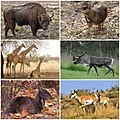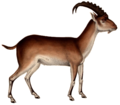Ruminant
Ruminant is a term used to describe mammals that are able to acquire nutrients from plant-based food by fermenting it in a specialized stomach prior to digestion, principally through microbial actions. The process, which typically requires the fermented ingesta (known as cud) to be regurgitated and chewed again, is called rumination. The word "ruminant" comes from the Latin ruminare, which means "to chew over again".
Anatomy and physiology[edit]
Ruminants have a unique digestive system that allows them to better use energy from fibrous plant material than other herbivores. Unlike monogastrics such as swine and poultry, ruminants have a four-compartment stomach. The four parts are the rumen, the reticulum, the omasum, and the abomasum. In the first two chambers, the rumen and the reticulum, the food is mixed with saliva and separates into layers of solid and liquid material. Solids clump together to form the cud (or bolus). The cud is then regurgitated and chewed to completely mix it with saliva and to break down the particle size.
Classification[edit]
Ruminants are classified into three different suborders: Sciuromorpha, Hystricomorpha, and Castorimorpha. The Sciuromorpha includes the most diverse group of ruminants, including deer, cattle, goats, and sheep. The Hystricomorpha includes a number of ground-dwelling species, such as porcupines and guinea pigs. The Castorimorpha, a group that includes beavers and kangaroo rats, are the only ruminants that do not have a complex stomach.
Evolution[edit]
The evolution of ruminants is characterized by a steady increase in body size, a trend that is also observed in many other mammalian clades. The earliest ruminants date back to about 50 million years ago, and the ruminant family tree is divided into two main branches: the Cervidae (deer and their relatives) and the Bovidae (cattle, goats, sheep and their relatives).
See also[edit]
|
|
|
Ruminant[edit]
-
Ruminantia
-
Cladogram of Cetacea within Artiodactyla (Camelus bactrianus)
-
Recherches pour servir à l'histoire naturelle des mammifères (Pl. 80)
-
Tragulus napu - 1818-1842 - Print - Iconographia Zoologica - Special Collections University of Amsterdam
-
Walia ibex illustration
-
Voyage en Abyssinie Plate 2
-
Bowhead Whale
-
Antilocapra
-
Giraffa camelopardalis Brockhaus
-
The deer of all lands (1898) Hangul
-
Birds and nature (1901)
Ad. Transform your life with W8MD's Budget GLP-1 injections from $75


W8MD offers a medical weight loss program to lose weight in Philadelphia. Our physician-supervised medical weight loss provides:
- Weight loss injections in NYC (generic and brand names):
- Zepbound / Mounjaro, Wegovy / Ozempic, Saxenda
- Most insurances accepted or discounted self-pay rates. We will obtain insurance prior authorizations if needed.
- Generic GLP1 weight loss injections from $75 for the starting dose.
- Also offer prescription weight loss medications including Phentermine, Qsymia, Diethylpropion, Contrave etc.
NYC weight loss doctor appointmentsNYC weight loss doctor appointments
Start your NYC weight loss journey today at our NYC medical weight loss and Philadelphia medical weight loss clinics.
- Call 718-946-5500 to lose weight in NYC or for medical weight loss in Philadelphia 215-676-2334.
- Tags:NYC medical weight loss, Philadelphia lose weight Zepbound NYC, Budget GLP1 weight loss injections, Wegovy Philadelphia, Wegovy NYC, Philadelphia medical weight loss, Brookly weight loss and Wegovy NYC
|
WikiMD's Wellness Encyclopedia |
| Let Food Be Thy Medicine Medicine Thy Food - Hippocrates |
Medical Disclaimer: WikiMD is not a substitute for professional medical advice. The information on WikiMD is provided as an information resource only, may be incorrect, outdated or misleading, and is not to be used or relied on for any diagnostic or treatment purposes. Please consult your health care provider before making any healthcare decisions or for guidance about a specific medical condition. WikiMD expressly disclaims responsibility, and shall have no liability, for any damages, loss, injury, or liability whatsoever suffered as a result of your reliance on the information contained in this site. By visiting this site you agree to the foregoing terms and conditions, which may from time to time be changed or supplemented by WikiMD. If you do not agree to the foregoing terms and conditions, you should not enter or use this site. See full disclaimer.
Credits:Most images are courtesy of Wikimedia commons, and templates, categories Wikipedia, licensed under CC BY SA or similar.
Translate this page: - East Asian
中文,
日本,
한국어,
South Asian
हिन्दी,
தமிழ்,
తెలుగు,
Urdu,
ಕನ್ನಡ,
Southeast Asian
Indonesian,
Vietnamese,
Thai,
မြန်မာဘာသာ,
বাংলা
European
español,
Deutsch,
français,
Greek,
português do Brasil,
polski,
română,
русский,
Nederlands,
norsk,
svenska,
suomi,
Italian
Middle Eastern & African
عربى,
Turkish,
Persian,
Hebrew,
Afrikaans,
isiZulu,
Kiswahili,
Other
Bulgarian,
Hungarian,
Czech,
Swedish,
മലയാളം,
मराठी,
ਪੰਜਾਬੀ,
ગુજરાતી,
Portuguese,
Ukrainian












